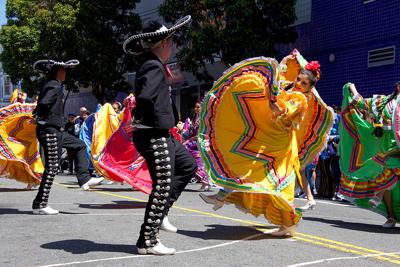
Dancers perform at a Cinco de Mayo celebration, showcasing the very best of Mexican and Latin American cultures, in San Francisco.
¡Hola!
Cinco de Mayo — what a fine day to commemorate Mexican culture, based on a historical event in 1862. Cinco de Mayo, observed this year on Sunday, May 5, is celebrated more so in the United States than in Mexico. It’s not the day of Mexican independence from Spain (that’s Sept. 16, 1810), but the day Mexicans eked out an unlikely victory over the French in the Battle of Puebla.
By 1861, Mexico had defaulted on debt payments due Britain, Spain and France. When Mexico could not meet payment demands, those three European countries sent naval forces to Veracruz, Mexico, as a show of force, to demand repayment. Mexico was able to negotiate a resolution with Britain and Spain, but not France.
On May 5, 1862, Napoleon III, then France’s ruler, took this opportunity to attempt to seize Mexican territory. Six thousand French troops attacked a small town, Puebla de Los Angeles. In response, Mexican President Benito Juárez summoned about 2,000 men, not an organized army, to defend it. Even though badly outnumbered and poorly supplied, Mexican’s inexperienced fighters prevailed.
After suffering heavy casualties that day, the French retreated, a significant symbolic Mexican victory. French forces didn’t finally withdraw until 1867, but that victory bolstered resistance to the French.
About two decades earlier, to settle the Mexican-American War, Mexico ceded a vast amount of territory in what is now California, Arizona, New Mexico, Texas, Nevada, Utah and parts of other states. Mexicans living in those areas, instantly new Americans, retained their culture, providing us with many words derived from Spanish.
In addition to the more obvious food-related words such as taco, nacho, tortilla, quesadilla and salsa, and many city names, such as Buena Vista, El Paso, Las Vegas and Los Angeles, we have Spanish-derived words related to geography (arroyo, caldera, canyon, mesa and sierra); animals (alligator, armadillo, burro, mosquito, mustang and bronco); culture (bodega, fiesta, macho, patio, rumba and tango), and cowboy culture (ranch, rodeo, stampede, lasso, corral, buckaroo and 10-gallon hat), to name just a few.
Ten-gallon hat? It has nothing to do with how much liquid a hat could hold. This curious expression likely derived from head gear of Mexican vaqueros (cowboys) who wore braided hatbands, called galóns, a sombrero with enough crown to hold 10 hatbands. Or it may be a corruption of Spanish “tan galán,” very gallant, handsome.
Words from Nahuatl, the language of the Aztecs who ruled Mexico between the 14th and 16th centuries, include avocado, chili, chipotle, chocolate, cocoa, coyote, guacamole, tomato, peyote, mezcal and shack.
This Cinco de Mayo, you can celebrate Mexican culture by making guacamole. It’s easy. All you need is avocados, an onion, salt, cilantro, a lime and, if you like it hot, serrano peppers or jalapeno. Listen to mariachi music, sip a margarita and for more about the history of the Battle of Pueblo and its profound impact on the Civil War — possibly saving the Union from defeat — go to the Library of Congress' blog (blogs.loc.gov/loc) to read more about The Roots of Cinco de Mayo: The Battle of Puebla.
¡Hasta luego!


